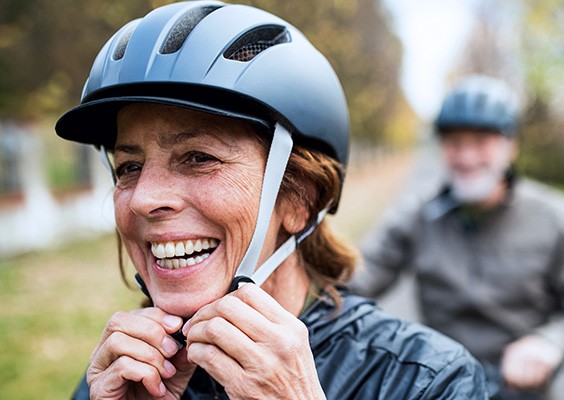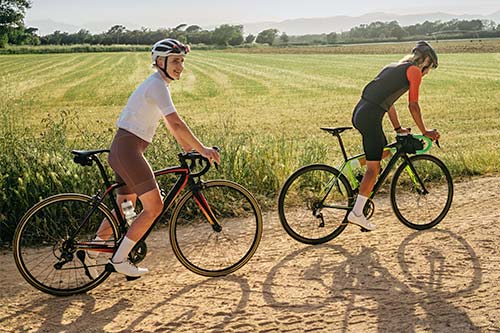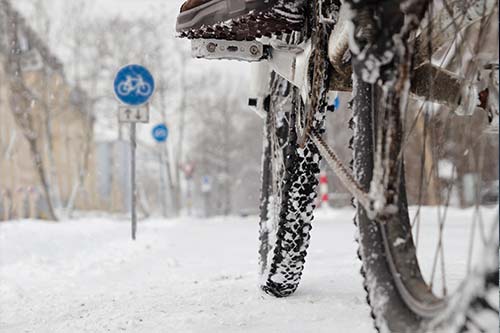
A few tips for staying safe and having fun on your bike!
- Cycling is fun, good for the environment and keeps you fit.
- It's no wonder that cycling is proving to be an increasingly popular way to get around.
However, more cyclists on the road sadly means more cycling accidents. Follow these tips to reduce your chances of an accident and make your cycling more fun the whole year round!
A few things to remember
Watch your speed
It can feel great to build up some speed on your bike. Still, it's important to adjust your speed and slow down when necessary. This might be if poor weather has made the road slippery, for example, but also when it's busy and you have to consider the safety of other road users like cyclists, lorries, cars or pedestrians.
Don't get distracted
Most accidents happen because we fail to notice hazards in time or react too slowly.
Make eye contact with people crossing your path. If they're not looking at you, they might not have seen you.
It’s a good idea to put your smartphone away while you’re cycling. After all, you can’t cycle safely if you’re looking at a screen or getting distracted by notifications.
Noise-cancelling earbuds or headphones that work a little too well are also a bad idea while you’re on your bike! It’s important to make sure you can always hear your surroundings in order to cycle safely.
Helmets are more than just a fashion statement
Wearing a quality helmet while cycling is a must. Choose a helmet that fits properly and make sure to replace it if you do get into a crash. By wearing a bicycle helmet, you are 60 to 80 per cent less likely to suffer a severe brain injury if you have an accident, according to emergency physician Pascal Vanelderen.
Make sure you have good visibility
If your vision is impaired, due to the weather for example, it's more difficult to assess a dangerous situation. Taking a moment to (safely) stop so you can wipe your fogged-up or rain-smeared glasses is never a bad idea.
Stay in control
There's an art to keeping your bike under control in all conditions, especially now that more than half of all bicycles sold are electric.
Check and see if everything is okay before you head out. It's important to check your brakes, tyres, saddle height and pedals. You should also carefully test your bike in a safe place to see how it behaves when you have to suddenly brake hard or swerve.
Pick your route wisely
Make sure you have:
- a safe route, which might not always be the shortest or fastest way, but is often a nicer way to cycle
- some leeway in your schedule, so you don't have to rush into traffic
What to watch out for when cycling in summer
- As soon as the sun is shining, it's easy to feel the itch to go cycling. When getting ready to take your bike back onto the road, a check-up at a cycle shop (which can be paid for with eco vouchers) is not an unnecessary luxury!
- If you cycle after dark, make sure you have working lights and reflectors.
- Pay attention to the strength of your lights and their position: modern bike lights can blind oncoming traffic.
- Summer is the ideal time to ride your bike to work. Unfortunately, many accidents take place while commuting. No fewer than 50% of bicycle accidents happen during the morning rush hour between 6 and 10 a.m. and 32% of the victims have been at their job for less than a year. These striking figures show just how important it is to have proper knowledge of your bicycle route, so pay extra attention when planning your bike ride and while cycling so you can master your route quickly.
- If you ride an electric bike and you can remove the battery, be sure to do so if there’s a heatwave, as your battery deteriorates quickly in hot weather.
Safer cycling in winter
- January is the month with the most bicycle accidents. It's no coincidence that it's also the darkest month of the year, often with slippery roads and snowfall. Be extra careful and adjust your speed in freezing weather. Regardless of the conditions, it's a good idea to wear light-coloured or fluorescent clothes when out on your bike. Finally, your cycling gear should always include a helmet irrespective of whether the roads are slippery or not. If you have rechargeable bike lights, be sure to schedule a regular time to recharge them so that you’ve always got light while you’re cycling. It’s never a bad idea to carry a spare set, as well.
- Check your tyres: a firm profile and a little less air in the tyres gives a better grip on a slippery road. You can also get winter tyres for bikes!
- If you have an electric bike, make sure your battery is charged as cold weather drains your battery faster.



